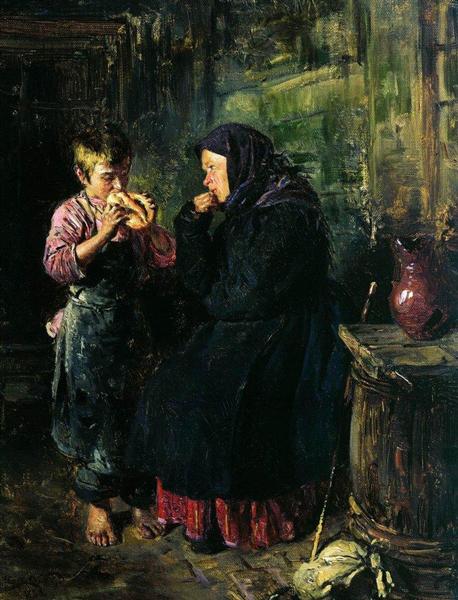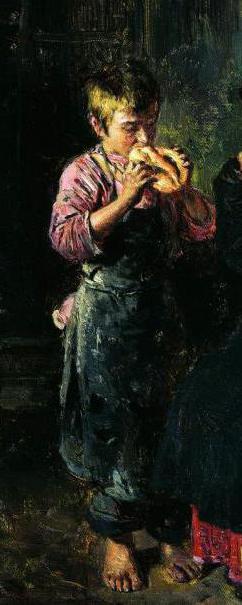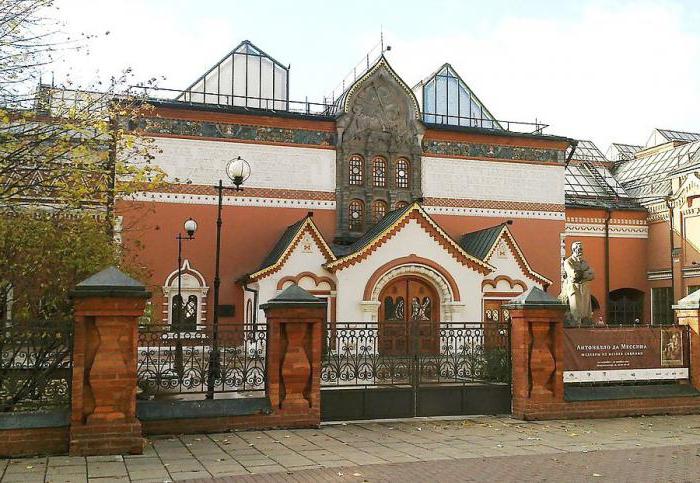Why the picture is called a date. Description of the painting by Vladimir Makovsky “Date

Painted in 1883 by Vladimir Makovsky, The Date is a typical work of the Wanderers, describing the difficult life of the common Russian people.
The artist depicted in the picture a meeting of a mother with her son. Mother - a typical peasant woman came from the village to the city to visit her son, who is in the apprenticeship. A sad look betrays her heavy feeling partly from rare meetings with her son, partly from fatigue. It can be seen that she broke up with her son and gave him to the apprentice because of the great need for a family.
The boy eagerly eats the kalach that his mother brought him. It looks painful and serious over the years - it can be seen that the working conditions are very poor - it is winter outside, and he does not have shoes, he has only a dirty shirt and pants from his clothes, and they will put on the same dirty apron.
The meeting of the mother and son takes place also in a rather dirty room with an earthen floor. The artist deliberately used dark colors when writing this picture to convey the particular tragedy of the situation: it seems that there may not be a next meeting. Often used by the Wanderers, the plot about the tragedy of ordinary Russian people always resonates with the hearts of the audience, making them sympathize and empathize with the heroes of the paintings.
Year of painting: 1883.
Dimensions: 40 x 31.5 cm.
Material: canvas.
Technique: oil.
Genre: genre painting.
Style: realism.
Gallery: State Tretyakov Gallery, Moscow, Russia.
More paintings by Vladimir Makovsky:
The composition of the painting "Date" Makovsky is included in the curriculum. When seventh graders are trained to describe the appearance and feelings of the characters, this picture fits perfectly. We will analyze its features in detail.
History of the painting
The famous canvas of the artist Makovsky Vladimir was painted at the end of the century before last, in 1883. It describes the long-awaited meeting of mother and son.
At first glance it is noticeable that the financial situation of the characters in the picture leaves much to be desired. The plot of this picture reflects the situation in which ordinary peasants found themselves after the abolition of serfdom.
It was this period that was reflected in his work by Makovsky (“Date”). should contain information about the time of its writing.
Many parents of that time had to give their older children to work in order to feed themselves and younger children. It seems that the boy in the picture is very small. In appearance, he did not give ten years. But he already works in the city, in apprenticeships. Rich people took the poor children to their maintenance, paid them a penny. And the peasants had no choice but to give the child away so that he would not feel hunger and bring tiny, but money, into the house.
Mother came to visit her son. Their meeting takes place in some kind of dirty and uncomfortable room. This is probably the boy’s place of work.
Description of the color scheme must be included in the composition of the painting "Date" Makovsky. The author selects mostly dull and gloomy accurate. In this he emphasizes the sadness and tragedy of the situation. On the left we see the sun's rays breaking through the darkness, which indicates that there is a window in this room.
Mother's appearance
How sad and thoughtful is our mother! On the one hand, she is happy that she finally met her beloved son. On the other hand, it is unbearably painful to realize that her child is deprived of her childhood and forced to work.

She brought the boy a treat, probably of her own preparation. With sadness she looks at him.
The woman’s clothes indicate that she lives very poorly. A black coat worn over a colored dress is very modest. The scarf is also dark. Judging by how she is dressed, the time of year is late autumn or winter. Since ordinary people had very little money, it can be assumed that she came from the village on foot. Her face conveys fatigue from a long journey.
A mini-composition on the painting "Date" includes a description of the feelings of mother and son. They do not talk or even look into each other's eyes. Both are exhausted from hard life. Apparently, the woman is not at all old. But the hardships of existence deprived her of her youth and blooming beauty. The grief on her face is hard to convey in words.
The appearance of the son
A boy from an early age is forced to learn craftsmanship in apprenticeships. Life in the city does not please him at all. Let's look at his appearance. The first thing that catches your eye is a child without shoes. Judging by the fact that there is a cold season on the street, it is likely that the boy is freezing, but does not show this at all. An apron dirty from work is tied to a crumpled shirt. Probably, his mother caught him at work, and he had to break away to chat with her.

The child is very hungry. He eagerly eats a gift brought by his mother. An analysis of this episode is included in the essay on the painting "Date" by Makovsky. The guy has a hard life: he is not fed enough, not provided with clothes and shoes.
The boy’s face is very serious. Life circumstances forced him to become an adult beyond his years. The child early knew all the difficulties of a poor, miserable life. The look of this guy causes a feeling of pity and worry for him. After a short meeting with his mother, he will again have to start hard work. He will remember his family and again wait for the long-awaited meeting.
Conclusion
The composition of the painting "Date" by Makovsky, students write in the course of development of speech in the Russian language. This canvas perfectly conveys the sad and difficult situation of the people of that time. Today it is stored in the Tretyakov Gallery.

Before us are characters unfamiliar to us. However, we can assume that they are the personification of the whole poor peasantry, forced to work for a penny and begging.
Be careful when starting this job. Many students, having misread the author’s surname, write: "Composition based on Mayakovsky’s painting" Date "." Surname of the artist - Makovsky! And Vladimir Mayakovsky is a poet with whom their surnames are consonant.
V.E. Makovsky is one of the best artists of the 19th century. With his paintings, the author made people think about the problems that were relevant at that time. Most of his works depict a particular situation in which the realities of his time are displayed. One of his best paintings is called "Date." Let's see what is depicted on it and why it is considered one of the best in his work.
In the foreground are the main characters: mother and son. For a long time they did not see each other and finally met.
From the eyes of the mother you can understand how glad she is to see her son. Apparently, she has come a long way to meet him. The artist draws the attention of the audience to a cane and a dust bag. We understand that a woman is sick, but still ready for anything, for the sake of meeting with her child. Her nose was red with frost, but she was still glad to see her child.
The son eagerly bites into the roll that his mother brought him. The boy is completely focused on food. There is nothing surprising. In the late 19th century, children often left home at a young age for part-time jobs. Most often, they became apprentices - they helped masters in the hardest work. They carried heavy objects, did all the housework. Often this led to death.
The fact that the boy is difficult can be judged by his appearance. His clothes are covered in dust. It is evident that she is old and worn. Plus, he's barefoot. Perhaps it is insanely difficult for him in the cold seasons.
You can see sadness in your mother’s eyes. This is not surprising, because, most likely, she herself sent the dignity to work part-time. She could have picked him up, but then their family would not have the means to feed themselves.
This simple picture V.E. Makovsky raises the problem of poverty of the peasantry in the 19th century. Despite the abolition of serfdom, the life of the population did not become easier. There wasn’t even enough money for food, much less for clothes. Everyone survived as best he could. Someone tried to earn money by growing food in the garden. Some went to the city to earn money.
Also, the main character of the picture, makes money through black labor for the sake of his family. He gave his happy childhood for the welfare of loved ones.
The place where the heroes meet is like a workers' rest room. She is dirty and dark. All that is in it is a jug of water in order to quench your thirst. The window is very small, so there is little light in the room.
The whole picture is painted in dark colors, which sets the desired atmosphere. The audience empathizes with the heroes, because he realizes, perhaps, the heroes will not meet soon. It is increasingly difficult for a mother to visit her son. Hard work can destroy a boy at any moment.
Summing up, I want to say V.E. Makovsky is a real genius. He is able to create a canvas with a couple of brush movements that will make the heart of any person tremble. Despite the gloominess of the “Date” painting, it deservedly has the title of a masterpiece of Russian painting. Without tears, it’s hard to watch a sad mother meet her hungry son.
Description of the painting by Makovsky “Date”
A very warm and touching picture of Makovsky V.E., it affects the depth of the soul, where it is human nature to hide tenderness, putting it in the rank of weak qualities.
“Date”, on the contrary, proves how strong love is, and therefore it is necessary for everyone, it is vitally important.
This is a feature of the maternal feeling.
But much can be gleaned from the image of the child.
What details of the picture were interesting to me? For a long time I could not tear myself away from my mother's face.
It seems that this is not an old woman.
But life broke her.
She is not just sad, she is tired.
Caring for everyone and everything made her saggy, with eyes sad from pain.
She cannot help but think and care about her son.
Life so happened that she was forced to give it to an apprentice.
Thinking about his future, so that his own child had a profession, and therefore a piece of bread, she was forced to tear him out of the usual environment.
Even a plant, when it is transplanted, gets sick.
Mother deliberately deprived her son of the house, her love, which she can now devote only in fits and starts.
She understands that her little child now lives in cold and hunger.
And how can she try to take care of him.
And now the next meeting is depicted.
Each of them missed each other, they have something to talk about, much to say.
They want to hug, feel the warmth.
But now there is neither time nor opportunity.
Only the facial expression of the mother is trying to convey all the accumulated warmth and pain.
The portrait master portrayed a woman of great strength and glory, described by poets as being able to do different things, and even feats, helpless.
This is the moment when she is unable to change anything.
At the same time, the appearance of the baby does not at all indicate his ability to work hard physically.
And only a doomed and stubborn look says that he has embarked on the path of suffering and is ready to go all the way, whatever the cost.
Now he is barefoot and hungry, in torn clothes and afraid to even look up at his own person, so as not to cry like a child.
But he can stand it.
And someday he will be a master himself.
Now he promises himself this, otherwise he cannot stand it.
And he promises that he will never be as cruel as his master.
He will respect workers and students, and will not allow them to be hungry.
Will it be? Hardly.
When he becomes an adult, from the severity of his childhood, the soul will become rougher, callous.
Mother looks at him and seems to understand all this and sees her maternal instinct.
And she is sad that her child is doomed to misfortune, no matter what.
There is no miracle that will fix this.
And she is very, very sorry for him.
Thank you very much to the painter who so simply portrayed the images, and at the same time, drew the path to true happiness - this is love and kindness.
Otherwise, it will not work.






